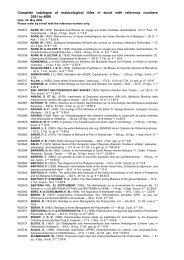Madeira Canary Islands Azores – Fishes Dr. Peter Wirtz
Madeira Canary Islands Azores – Fishes Dr. Peter Wirtz
Madeira Canary Islands Azores – Fishes Dr. Peter Wirtz
You also want an ePaper? Increase the reach of your titles
YUMPU automatically turns print PDFs into web optimized ePapers that Google loves.
Brown filefish (Stephanolepis hispidus)<br />
Up to 18 cm long. <strong>Madeira</strong>, <strong>Canary</strong> <strong>Islands</strong>, <strong>Azores</strong>. 5 <strong>–</strong> 50 m depth.<br />
Filefishes have small scales with tiny spines; their skin feels like sand paper and, indeed, was used as such in<br />
old times. The pelvic fins are even more reduced than in trigger fishes. Like trigger fishes, they swim with<br />
rowing movements of the dorsal and anal fins. The Brown filefish lives between plants over rocky and soft<br />
bottoms. In the male, the first ray of the dorsal fin is elongated (insert; spotted night time colour of the animal)<br />
but not in the female (photo bottom right). At the <strong>Azores</strong>, this species is only known from two animals seen in<br />
a harbour, that is, it was probably transported there by man. Photos <strong>Peter</strong> <strong>Wirtz</strong>.<br />
142<br />
Pufferfishes (Tetraodontidae)<br />
Sharpnose puffer (Canthigaster capistrata)<br />
Up to 10 cm long. <strong>Madeira</strong>, <strong>Canary</strong> <strong>Islands</strong>, <strong>Azores</strong>. 2 <strong>–</strong> 40 m depth.<br />
The scientific name of the Pufferfishes is Tetraodontidae, which means „having four teeth“. The teeth have<br />
fused into two large teeth, in the upper and in the lower jaw. When feeling endangered, Pufferfishes can<br />
inflate themselves by swallowing water (insert, below).<br />
The Eastern Atlantic Sharpnose puffer is now recognized as a valid species; previously, it was thought to be<br />
the same as that in the Western Atlantic (Canthigaster rostrata). Females defend their territories against other<br />
females and also against small males. Large males defend a territory that contains those of several females.<br />
Juveniles (insert) like to hide between the spines of long-spined sea urchins. A very rare species at the <strong>Azores</strong><br />
(more records from there are needed). Photos <strong>Peter</strong> <strong>Wirtz</strong>.









